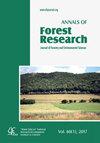气候变化背景下罗马尼亚欧洲银杉的适应性遗传潜力
IF 2.9
3区 农林科学
Q2 FORESTRY
引用次数: 15
摘要
对二十六个欧洲银杉本地种群进行了五次种源测试,以评估种群对气候变化的反应。31岁时树木的高度生长和乳高直径被视为响应变量,8个气候变量被视为预测变量。计算了1961年至2010年试验地点和种源产地的气候变量。实验揭示了物种水平上的巨大遗传变异和对气候变化的可塑性反应,这当然有遗传基础。气候变暖导致位于较低植被层的试验区种源生长增加。但生长受到种植地年平均气温和年降水量的显著影响,也受到种源地和试验地年平均温度、年降水量、7月和7月月月平均气温的差异的显著影响。在森林生殖材料转移的情况下,这些气候因素应该与风险有关。如果该物种将在当前最佳气候之外种植,则应特别考虑种源来源。在1.30m处,总高和总直径最好的种源来自于接近现场气候的原产地气候,转移距离较小。根据生长反应函数和RCP4.5情景,我们可以预测2050年代和2100年代物种分布的变化,并确定脆弱种群。本文章由计算机程序翻译,如有差异,请以英文原文为准。
Adaptive genetic potential of European silver fir in Romania in the context of climate change
Five provenance tests with twenty-six European silver fir autochthonous populations were used in order to assess the response of populations to climate change. Height growth and diameter at breast height of trees at age 31 years were considered as response variables and eight climate variables as predictors. Climatic variables for the trial sites and for origin location of provenances were calculated from 1961 to 2010. The experiments revealed a large genetic variability within species level and a plastic response to climate change, which certainly has a genetic basis. The transfer to warmer climate has resulted in an increase of the provenances growth, in the trial sites situated on the lower vegetation layer. But growth is significantly influenced by mean annual temperature and annual precipitation of planting site and also by the differences in mean annual temperature, annual precipitation, monthly mean temperature in July and July precipitation between provenance site and test site. These are the climatic factors which should be associated with risk in case of the transfer of forest reproductive materials. The provenance origin should be especially considered if the species will be planted outside of its current climate optimum. The best provenances in terms of total height and diameter at 1.30 m came from origin climate close to site climate, small transfer distances. Based on growth response functions and RCP4.5 scenario, we could project the shifts in species distribution for 2050s and 2100s and identify vulnerable populations.
求助全文
通过发布文献求助,成功后即可免费获取论文全文。
去求助
来源期刊

Annals of Forest Research
FORESTRY-
CiteScore
2.20
自引率
11.10%
发文量
11
审稿时长
12 weeks
期刊介绍:
Annals of Forest Research is a semestrial open access journal, which publishes research articles, research notes and critical review papers, exclusively in English, on topics dealing with forestry and environmental sciences. The journal promotes high scientific level articles, by following international editorial conventions and by applying a peer-review selection process.
 求助内容:
求助内容: 应助结果提醒方式:
应助结果提醒方式:


